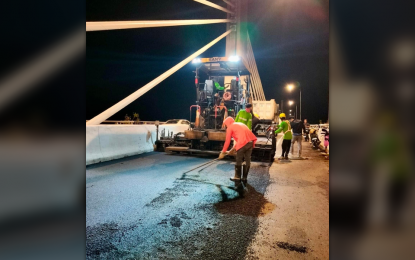COURTESY: PNA
Hey there, bridge enthusiasts and curious minds! If you've ever wondered what goes on behind the scenes of maintaining a massive piece of infrastructure like the Panguil Bay Bridge in Northern Mindanao, then buckle up! We're diving into the nitty-gritty of asphalt repairs, structural integrity, and what it takes to keep this crucial connector up and running.
First off, let's set the scene. Opened on September 27, 2024, the Panguil Bay Bridge is a whopping 3.17 kilometers long, stretching between Tangub City in Misamis Occidental and Tubod in Lanao del Norte. This bridge is not just a feat of engineering; it’s a vital piece of infrastructure that boosts regional connectivity and economic growth. However, like any hero in a great story, it faces challenges.
The bridge recently faced some wear and tear on its asphalt pavement, prompting the Department of Public Works and Highways (DPWH) to spring into action. But don’t worry! The structure itself is holding strong. The DPWH has assured everyone that the issues are limited to the asphalt surface, thanks to some overloaded trucks and Mother Nature’s torrential rains.
Imagine being part of the team that swoops in to save the day! That’s exactly what the contractor, Namkwang-Kukdong-Gumgwang joint venture (NKG JV), is doing. They've already kicked off emergency repairs on the Tangub City to Tubod direction, with plans to wrap up the Tubod to Tangub direction repairs by 7 a.m. Tuesday. Talk about working around the clock!
It’s like a well-choreographed dance—one side opens for two-way traffic while the other gets its much-needed facelift. Kudos to the crew for keeping things moving swiftly and safely, advising motorists to maintain a steady pace across the bridge.
So, what's causing all this commotion on the asphalt? Well, according to DPWH and their project consultant, Yooshin-Pyunghwa-Kyongho JV, the culprits are overloaded trucks. These behemoths, exceeding the bridge's 30-ton design capacity, are a bit too much to handle. Throw in some torrential rain, and you've got yourself a recipe for pavement deformation and potholes galore.
But fear not! The DPWH is on it, ensuring that the contractor replaces the damaged pavement at no extra cost. They’re also crafting a comprehensive repair plan, which includes a new asphalt mix design and waterproofing measures. It’s all about ensuring the bridge stands the test of time.
To prevent future headaches, strict enforcement of the anti-overloading policy under Republic Act 8794 is key. Senior Undersecretary Emil Sadain emphasizes that keeping overloaded vehicles off the bridge is crucial to maintaining its surface. By sticking to the prescribed weight limits, truck and trailer operators can help preserve the bridge and keep it in tip-top shape.
What’s next on the agenda? The DPWH UPMO-RMC 2 is teaming up with the DPWH Regional Office 10 to set up 24/7 weighing facilities at both ends of the bridge. Portable weighing scales are already in place, but round-the-clock monitoring is a bit tricky due to funding constraints. Hopefully, with some budget wizardry, they’ll manage to keep an eye on things day and night.
At the end of the day, the Panguil Bay Bridge stands as a testament to progress and resilience. It’s not just a structure of steel and asphalt; it’s a lifeline for the communities it connects. As repairs continue and plans for future-proofing are put into place, this bridge is set to serve Northern Mindanao for years to come.
So, next time you’re driving across this engineering marvel, take a moment to appreciate the hard work and dedication that keeps it standing strong. Here’s to smooth rides, scenic views, and the road ahead!




No comments:
Post a Comment